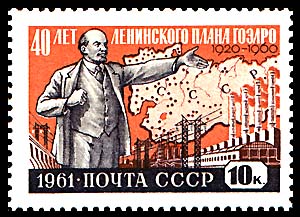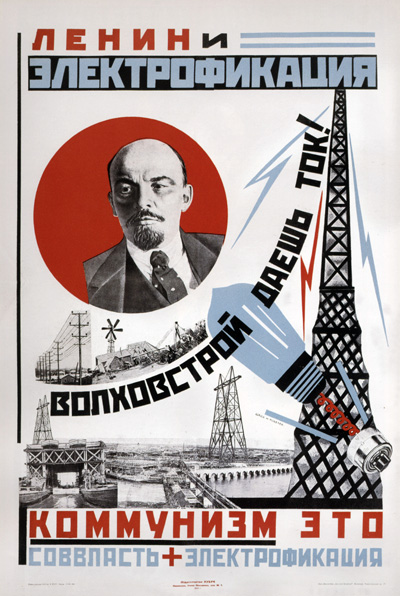By Eric Laursen (W&M Contributor)
In December 1920 Russia was embroiled in civil war, and Moscow was short on food and fuel, rapidly heading into a cold, dark winter. Yet rather than focusing on survival, the Bolsheviks launched a massive ten-year electrification campaign at the world-famous Bolshoy Theater. In defiance of a shortage of ink and paper, delegates to the Eighth Congress of Soviets were given 5000 copies of a four-color 50-page synopsis of the original 672-page plan. On a stage that usually held dying swans and singing divas, Lenin and the Director of the Soviet Electrification Commission gave rousing speeches in front of a map of the Soviet Union inset with light-bulbs, each designating a future power plant. Soviet historians later endowed the map with an almost supernatural power. According to one source, the lights of the Bolshoy were dimmed to accommodate it. Other accounts make the unlikely claim that the map caused blackouts in regions of Moscow. Whatever the wattage, this map of the future gained real power not through copper wires but through the propaganda machine of the Soviet Union, which reproduced its light not only in awestruck written accounts, but also on postage stamps, paintings, pins, and even children’s cartoons throughout the twentieth century.
H.G. Wells’s account of his interview with Lenin in October 1920 depicts the Soviet leader as a slightly unhinged visionary whose belief in the transforming power of science far exceeds the bounds of common sense (or science fiction!). Under Wells’s pen, Lenin becomes the ultimate mad scientist, launching with the electrification campaign “an age of limitless experiment” and seeing a “utopia of the electricians” superimposed on the ruined cities of a war-ravaged country. The materials and speeches surrounding the electrification campaign support Wells’s claim, as exemplified by this passage from a 1920 brochure: “And now every cultural center above all can be characterized by the glow of the electric fire that burns in it at night. The electric searchlight with its fiery sword cuts through the darkness of the night for tens of miles–these are the first rays of those electric suns that the utopians dreamed about.” In Lenin’s electrician’s utopia “cultural centers” would be marked not by a church, museum, or government building, but by “electric suns,” and eventually the entire world would become a single cultural center, a network of enlightened people all connected by Bolshevik power lines.
On a 1925 propaganda poster “Lenin & Electrification” we see the electrified landscape promised by Lenin’s map, a mechanized pastoral made possible only by tapping the unharnessed power of the earth: “Construction of the Volkhov hydroelectric dam will give current!” To the left of this arching proclamation is the Volkhov dam and to the right an electric tower that sends blue lightning bolts down to a light bulb, which points toward Lenin’s image, made celestial by his death the year before. At the bottom of the poster is the formula that Lenin delivered at the launching of the electrification campaign in 1920: Soviet Power + Electrification = Communism. After his death, Lenin’s image becomes a symbol for Soviet power, which links it to revolutionary tradition and makes of it the “electric sun” promised by the electrification campaign. Lenin and his light-bulb (nicknamed “Lenin’s lamp” during the electrification campaign) embody the variables in his formula. When added together they promise to produce communism, a state of being that requires the transformation of the natural world into an electrician’s utopia, a reworked landscape envisioned by Lenin’s map of the future.


